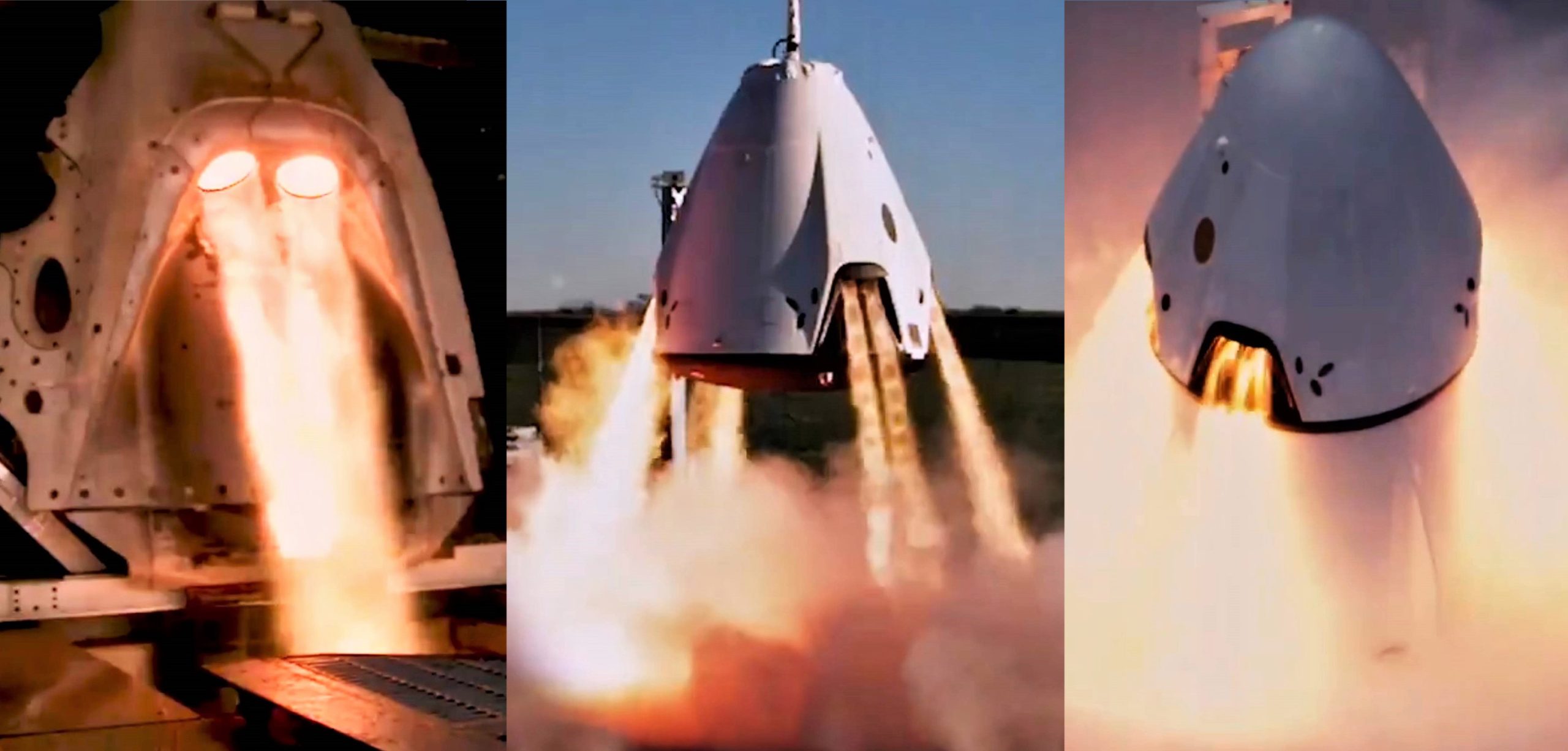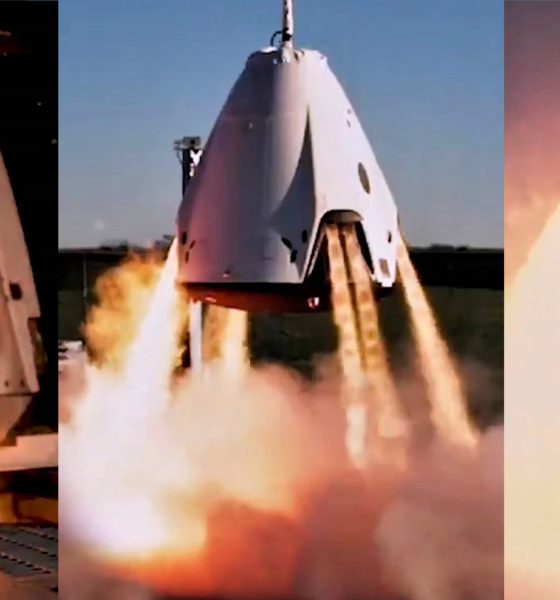

News
SpaceX highlights Crew Dragon SuperDraco thrusters as explosion investigation nears end
SpaceX has published a highlight reel touting “over 700 tests” of Crew Dragon’s SuperDraco abort thrusters at the same time as the company is about to close a failure investigation into a Dragon capsule’s April explosion, pinned primarily on abort-related hardware.
According to a September 6th meeting of NASA’s Aerospace Safety Advisory Panel (ASAP), SpaceX has nearly completed the ‘fault tree’ of Crew Dragon’s explosion, a term used to describe the process of analyzing telemetry and ruling out all possible failure modes. Once that tree is complete, the investigation can be finalized and SpaceX can implement all hardware and software changes needed to prevent similar failures from reoccurring. For the time being, this means that a 2019 launch of SpaceX’s inaugural crewed Dragon is almost certainly not in the cards, although early 2020 is still looking promising.
On April 20th, SpaceX was extremely quick to acknowledge that an anomaly had occurred during a planned static fire of flight-proven Crew Dragon capsule C201, recovered just one month prior after a flawless orbital launch debut. Soon after, an extremely low-quality video of a livestream of the static fire attempt was leaked, revealing that the capsule suffered a catastrophic explosion just moments before the ignition of its eight SuperDraco thrusters.
Incredibly, one of Crew Dragon C201’s SuperDraco ‘powerpacks’ (a pair of engines) was not only recovered intact after the explosion but static-fired at SpaceX’s McGregor, TX test facilities. A bit less than three months after the explosion, SpaceX and NASA officials hosted a press conference in July 2019 to discuss preliminary results from their joint Crew Dragon failure investigation. Some work remained to rule out other possibilities but NASA and SpaceX were confident enough to conclude that an exotic interaction between SuperDraco propellant and a leaky titanium valve likely triggered the explosion.
According to ASAP, SpaceX and NASA still have work to do before the investigation can be concluded, describing it as “nearly complete”. Additionally, the ASAP meeting continued what feels like an increasingly myopic focus on SpaceX’s carbon overwrapped pressure vessels (COPVs), used to store high-pressure helium on Falcon 9 and Heavy. COPVs have been partial causes of both of Falcon 9’s two operational failures, explaining NASA’s apparent prioritization of its certification.
Unspecified issues with parachutes were also raised for both Commercial Crew spacecraft, continuing a years-long trend of parachutes and COPVs taking up the majority of ASAP’s attention in public meetings. Boeing and SpaceX continue to test their parachute systems, both well into dozens of distinct tests after something like two years of concerted attempts to satisfy NASA requirements.
SpaceX has already demonstrated a successful orbital launch, reentry, parachute deployment, and splashdown during Crew Dragon’s March 2019 Demo-1 launch, as well as 18 successful Cargo Dragon parachute recoveries in the last seven years. Cargo Dragon did suffer one anomalous splashdown in 2018, but its partially redundant set of chutes still permitted a gentle and intact recovery.
Nevertheless, it appears that SpaceX and Boeing will have to continue performing parachute tests for the indefinite future. Boeing’s next milestone – an uncrewed orbital test flight (OTF) comparable to SpaceX’s Demo-1 mission – is expected to launch no earlier than October 28th according to Russian space industry sources. SpaceX’s next Crew Dragon milestone will be the spacecraft’s in-flight abort (IFA) test, scheduled no earlier than November 2019.
Check out Teslarati’s Marketplace! We offer Tesla accessories, including for the Tesla Cybertruck and Tesla Model 3.

News
Tesla starts showing how FSD will change lives in Europe
Local officials tested the system on narrow country roads and were impressed by FSD’s smooth, human-like driving, with some calling the service a game-changer for everyday life in areas that are far from urban centers.

Tesla has launched Europe’s first public shuttle service using Full Self-Driving (Supervised) in the rural Eifelkreis Bitburg-Prüm region of Germany, demonstrating how the technology can restore independence and mobility for people who struggle with limited transport options.
Local officials tested the system on narrow country roads and were impressed by FSD’s smooth, human-like driving, with some calling the service a game-changer for everyday life in areas that are far from urban centers.
Officials see real impact on rural residents
Arzfeld Mayor Johannes Kuhl and District Administrator Andreas Kruppert personally tested the Tesla shuttle service. This allowed them to see just how well FSD navigated winding lanes and rural roads confidently. Kruppert said, “Autonomous driving sounds like science fiction to many, but we simply see here that it works totally well in rural regions too.” Kuhl, for his part, also noted that FSD “feels like a very experienced driver.”
The pilot complements the area’s “Citizen Bus” program, which provides on-demand rides for elderly residents who can no longer drive themselves. Tesla Europe shared a video of a demonstration of the service, highlighting how FSD gives people their freedom back, even in places where public transport is not as prevalent.
What the Ministry for Economic Affairs and Transport says
Rhineland-Palatinate’s Minister Daniela Schmitt supported the project, praising the collaboration that made this “first of its kind in Europe” possible. As per the ministry, the rural rollout for the service shows FSD’s potential beyond major cities, and it delivers tangible benefits like grocery runs, doctor visits, and social connections for isolated residents.
“Reliable and flexible mobility is especially vital in rural areas. With the launch of a shuttle service using self-driving vehicles (FSD supervised) by Tesla in the Eifelkreis Bitburg-Prüm, an innovative pilot project is now getting underway that complements local community bus services. It is the first project of its kind in Europe.
“The result is a real gain for rural mobility: greater accessibility, more flexibility and tangible benefits for everyday life. A strong signal for innovation, cooperation and future-oriented mobility beyond urban centers,” the ministry wrote in a LinkedIn post.
News
Tesla China quietly posts Robotaxi-related job listing
Tesla China is currently seeking a Low Voltage Electrical Engineer to work on circuit board design for the company’s autonomous vehicles.

Tesla has posted a new job listing in Shanghai explicitly tied to its Robotaxi program, fueling speculation that the company is preparing to launch its dedicated autonomous ride-hailing service in China.
As noted in the listing, Tesla China is currently seeking a Low Voltage Electrical Engineer to work on circuit board design for the company’s autonomous vehicles.
Robotaxi-specific role
The listing, which was shared on social media platform X by industry watcher @tslaming, suggested that Tesla China is looking to fill the role urgently. The job listing itself specifically mentions that the person hired for the role will be working on the Low Voltage Hardware team, which would design the circuit boards that would serve as the nervous system of the Robotaxi.
Key tasks for the role, as indicated in the job listing, include collaboration with PCB layout, firmware, mechanical, program management, and validation teams, among other responsibilities. The role is based in Shanghai.
China Robotaxi launch
China represents a massive potential market for robotaxis, with its dense urban centers and supportive policies in select cities. Tesla has limited permission to roll out FSD in the country, though despite this, its vehicles have been hailed as among the best in the market when it comes to autonomous features. So far, at least, it appears that China supports Tesla’s FSD and Robotaxi rollout.
This was hinted at in November, when Tesla brought the Cybercab to the 8th China International Import Expo (CIIE) in Shanghai, marking the first time that the autonomous two-seater was brought to the Asia-Pacific region. The vehicle, despite not having a release date in China, received a significant amount of interest among the event’s attendees.
Elon Musk
Elon Musk and Tesla AI Director share insights after empty driver seat Robotaxi rides
The executives’ unoccupied tests hint at the rapid progress of Tesla’s unsupervised Robotaxi efforts.

Tesla CEO Elon Musk and AI Director Ashok Elluswamy celebrated Christmas Eve by sharing personal experiences with Robotaxi vehicles that had no safety monitor or occupant in the driver’s seat. Musk described the system’s “perfect driving” around Austin, while Elluswamy posted video from the back seat, calling it “an amazing experience.”
The executives’ unoccupied tests hint at the rapid progress of Tesla’s unsupervised Robotaxi efforts.
Elon and Ashok’s firsthand Robotaxi insights
Prior to Musk and the Tesla AI Director’s posts, sightings of unmanned Teslas navigating public roads were widely shared on social media. One such vehicle was spotted in Austin, Texas, which Elon Musk acknowleged by stating that “Testing is underway with no occupants in the car.”
Based on his Christmas Eve post, Musk seemed to have tested an unmanned Tesla himself. “A Tesla with no safety monitor in the car and me sitting in the passenger seat took me all around Austin on Sunday with perfect driving,” Musk wrote in his post.
Elluswamy responded with a 2-minute video showing himself in the rear of an unmanned Tesla. The video featured the vehicle’s empty front seats, as well as its smooth handling through real-world traffic. He captioned his video with the words, “It’s an amazing experience!”
Towards Unsupervised operations
During an xAI Hackathon earlier this month, Elon Musk mentioned that Tesla owed be removing Safety Monitors from its Robotaxis in Austin in just three weeks. “Unsupervised is pretty much solved at this point. So there will be Tesla Robotaxis operating in Austin with no one in them. Not even anyone in the passenger seat in about three weeks,” he said. Musk echoed similar estimates at the 2025 Annual Shareholder Meeting and the Q3 2025 earnings call.
Considering the insights that were posted Musk and Elluswamy, it does appear that Tesla is working hard towards operating its Robotaxis with no safety monitors. This is quite impressive considering that the service was launched just earlier this year.








